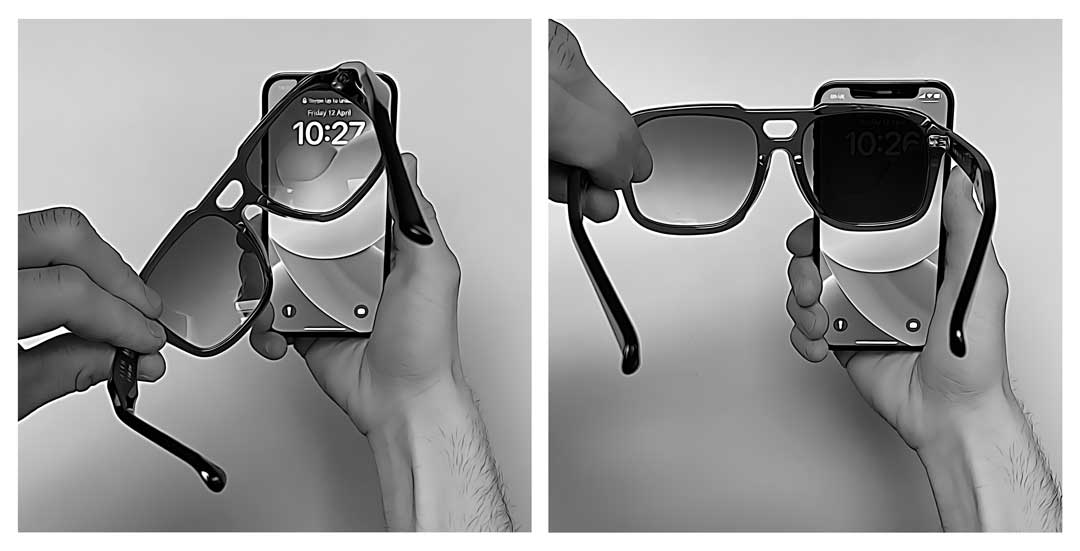When sunlight bounces off the ground, water or snow, it becomes incredibly harsh to see properly, even with regular sun lenses on.
Polarised lenses have an advantage compared to regular sun lenses as they block reflected sunlight to improve your visual comfort and optical clarity.
During prolonged sun exposure, polarised lenses prevent you from squinting and straining to see. This is why they’re considered a superior lens-type making them popular for long-term visual tasks such as driving and outdoor sports.
Polarised lenses are just as UV protective as non-polarised equivalents.

Are polarised lenses better?
Polarised lenses are better at filtering visible light by blocking glare, but they aren't any better at blocking invisible ultraviolet light (UV). By blocking strongly reflected sunlight, they only provide better visual comfort by alleviating eye strain and offering better colour and contrast perception.
Polarised lenses are equally UV protective as non-polarised equivalents.
Are Polarised lenses worth it?
Despite their extra cost, polarised lenses are worth it if you spend long durations in the sun and require extended visual focus. For driving or water sports, the accumulative effects of eye-fatigue are lessened by polarised lenses over long durations or repeated exposure.
On average, polarised lenses are 30% more costly than non-polarised equivalents.

How do polarised lenses work?
Polarised lenses use a filter applied externally to the lens surface or sandwiched internally within two lens layers. This filter is a very thin film containing tiny rows of chemically aligned molecules which are closely packed together in a vertical orientation. This orientation is what blocks horizontal light waves (glare) from passing through the lens. This is when visible sun light bounces off water or any flat surface which become condensed and strenuous to look towards.
As long as polarised lenses are at the correct orientation (90 degrees) to a glare-source, they block the horizontal light waves and allow vertical ones to pass through. This results in a smoother, more consistent visual experience that puts less strain on your eyes.

How do I know lenses are polarised?
To determine if your lenses are polarised, simply position them in front of a digital screen. This simple test for polarised sunglasses can be performed with virtually any device featuring an LCD screen, such as a smartphone or computer monitor.
Follow these five simple steps to tell if your sunglasses are polarised:
- Grab your mobile phone (any LCD screen device will work).
- Hold your sunglasses at 90 degrees in front of the screen.
- Look through the lens overlapping the screen while slowly rotating the frame so they're at the correct orientation.
- Check whether there's a change in the brightness of the light.
- If the screen darkens, the lenses are polarised.
Another method is to overlap two sunglasses frames at opposing angles. One horizontal and one vertical. If the lenses are polarised, they'll block nearly all visible light. For more details, check out the article below.
How to know if sunglasses are polarised

Are polarised lenses darker?
Polarised lenses can be marginally darker to look through because their lenses block-out horizontal light. This reduces harsh reflections whilst making it easier to see finer details and colour. Non-polarised equivalents don’t do this, therefore can seem lighter depending on their tint darkness.
The darkness of sun lenses has nothing to do with UV protection and is simply a measure of how much visible light they absorb. The more light lenses absorb, the darker they are to look through which is measured as a percentage known as visible light absorption percentage (ABS%.)
Recreational sun lenses can vary between 43% - 85% ABS which classifies them as category 3. There are 5 sunglasses categories in total which are determined by ABS%.
What are the 5 sunglasses categories?

Are polarised lenses good for driving?
Yes. Reduced glare and enhanced contrast make polarised lenses an excellent choice for driving. Over long journeys, your eyes are collectively put under less strain as you focus on the road ahead. This aids alertness and reaction times as your eyes won't have to work as hard to process real-time changes in traffic, road surface and traffic signals.
In the short term, polarised lenses are noticeably sharper to look through with greater colour perception and smoother levels of contrast.
In the long term, polarised lenses vastly reduce eye strain which compounds over hours, days or even weeks of sun exposure.
The best example of this would be a two week yachting holiday at the Mediterranean. Day after day, your eyes are strained by harsh reflections from the water's surface. Accumulatively, this would be taxing on your eyes unless you wore polarised lenses.
Over time, the divergence of performance between polarised and non-polarised sunglasses is what sets these lenses apart.

What are polarised lenses good for?
Polarised lenses are good if you spend a lot of time outdoors during activities which require long periods of exposure and visual focus. They're especially beneficial for water sports such as fishing, sailing or paddle boarding to diminish harsh reflections from the water. Popular applications include;
- Driving in bright daylight or wet road conditions
- Fishing and boating to reduce glare from water surfaces
- Golfing for a clearer view of the fairway and greens
- Outdoor photography to reduce reflections and improve colour saturation
- Hiking to reduce glare and enhance natural colours and contrast in scenic views
What are the disadvantages of polarised lenses?
Despite their ability block glare, polarised lenses do have their own set of disadvantages. For some people, they have certain negative side affects which include;
#1 Higher cost
Polarised sunglasses are estimated to be 25% more expensive (on average) across various major sunglasses brands. If you're on a budget, this additional cost may limit your options.
#2 Darken LCD screens
Due to the filters within polarised lenses, they often darken LCD screens such as those found on phones, car GPS systems and other electronic devices. This can get frustrating if you need to regularly observe these kinds of screens, especially whilst driving. (This is why pilots aren't allowed to wear polarised sunglasses!)
#3 Reduced visibility in low light
Because polarised sunglasses block (glare) they're subsequently darker to look through. In low light conditions, such as dawn or dusk, you might find it hard to see properly. Wearing polarised sunglasses whilst driving, walking or running at these times of day can be dangerous, as they reduce visibility.
#4 Limited lens colours
Polarised lenses are often limited to fewer lens colours, typically being limited to grey, brown or green tints; especially if you need prescription sun lenses. If you prefer a particular non-standard lens colour, then you may have to go for non-polarised sunglasses, as they offer more colour options.
#5 Polarised Sunglasses Can Cause Nausea
Polarised sunglasses function by filtering out horizontally oriented and intensified sunlight, significantly reducing glare from reflective surfaces. However, they can modify the perception of distance and depth, leading to disorientation, dizziness, and nausea for some individuals. Additionally, because these lenses block horizontal light, they may cause headaches for the wearer headaches.
It's important to note that these side effects are relatively rare. The majority of individuals who use polarised lenses report an enhanced visual experience, enjoying glare-free vision and reduced eye strain.
How can you tell if sunglasses are UV protected?
Legitimate UV protective sunglasses should bear the internationally recognised CE marking somewhere on the frame, typically on the interior surface of the temple arms or frame front. This signifies that the lenses can block 99% of ultraviolet light up to 380 nanometres (nm).
The CE marking should be present on any sunglasses frame which means the lenses conform to the European standard: EN 1836:2005.
Beyond the mandatory CE marking is the UV400 rating, otherwise known as 100% UV. This rating means the lenses can block 99% of UV light up to 400nm (slightly more than the minimum 380nm CE standard).
UV400 are the most protective sun lenses you can get.
Summary
In short bullet points, list the key points of this article.
- Polarised lenses enhance visual clarity by reducing glare.
- They are particularly useful for activities near water and driving.
- Some individuals might experience side effects such as disorientation, dizziness, or nausea.
- Rare cases of headaches have been reported due to the blockage of horizontal light.
- The majority benefits from glare-free vision and reduced eye strain with polarised lenses.
- UV protective sunglasses should have the CE marking to denote adherence to European standard EN 1836:2005.
- UV400 provides the highest level of UV protection, blocking 99% of UV light up to 400nm.
Hopefully you found this article helpful. If so, please check out our other polarised sunglasses blog posts for more insights.
Thanks for stopping by.